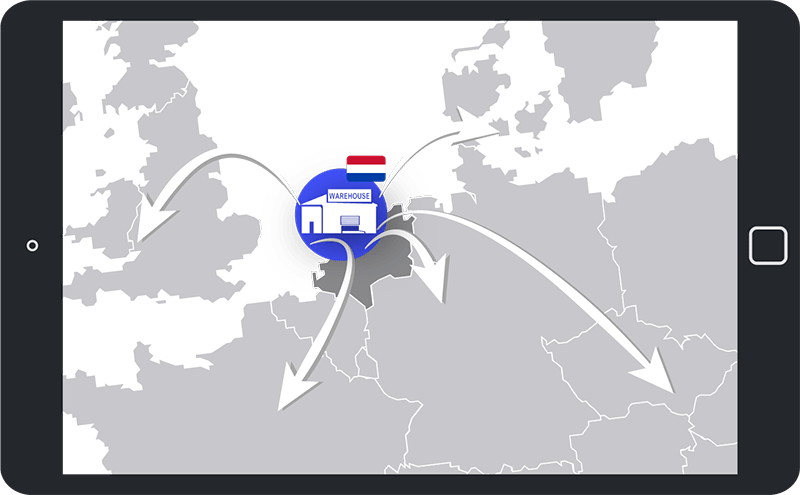

All you need to know about VAT registration in the Netherlands

VAT Guide
VAT in the Netherlands is called "Belasting over de Toegevoegde Waarde" (BTW) and the local tax authority is the Belastingdienst. The standard VAT rate in the Netherlands is 21%.
As a foreign company conducting taxable activities in the Netherlands, you have to register for a Dutch VAT number.
EU companies can register directly with the local tax authority (Belastingdienst), so long as they know how to fill out their application and can navigate doing so in Dutch.
For non-EU companies, a fiscal representative needs to be appointed, to be jointly and severally liable for your VAT compliance.
SimpleVAT helps both EU and non-EU companies get registered for a Dutch VAT number and can also handle filing your monthly VAT returns in Netherlands.
Who is VAT liable in the Netherlands
For e-commerce businesses operating in Europe, registering for VAT in the Netherlands is necessary if you have stock stored there. Here are the primary situations that require VAT registration in the Netherlands for non-Dutch companies:
Participating in Amazon's FBA programs and storing stock in Spanish warehouses
Storing stock in a warehouse that you have rented to keep your products and fulfill orders.

Storing stock in a Dutch warehouse rented from a 3PL fulfillment provider triggers the obligation to register for VAT in the Netherlands. It's advisable to complete your registration before sending your stock to avoid customs clearance issues and import VAT reclaims.
For sellers utilizing Amazon FBA, it's important to understand the different FBA programmes and their VAT implications. Amazon's FBA programmes include:


Choose one country for stock storage, requiring registration in that country (e.g., Spain).

Choose multiple countries for stock storage, necessitating immediate VAT registration in the selected countries.

Distribute stock across up to 8 countries, including Spain. Register for VAT in all 8 Amazon FBA Pan European countries.
The process for obtaining a Dutch VAT ID differs slightly for EU and non-EU companies:
Requirements for becoming VAT registered
If you don't maintain stock in the Netherlands, you don't need to register for a VAT number in the Netherlands. However, you still have VAT obligations if you sell to Dutch customers. Two main scenarios determine your VAT obligations for sales to Dutch customers without stock in the country:
Common questions answered
The standard VAT rate in the Netherlands is 21%. However, there are reduced VAT rates applicable to certain goods and services. There is one reduced VAT rates in the Netherlands.
The reduced rate is applied to specific categories of goods and services, such as food items, books and newspapers (including Ebooks and digital newspapers), and some medical supplies for disabled persons and pharmaceuticals.
For a more detailed breakdown of all VAT rates and categories of goods, please visit our EU VAT rates page.
Before 2021, a distance selling threshold determined VAT registration obligations in the Netherlands. For foreign businesses, this threshold was €100,000 in annual turnover. However, in 2021, this system was replaced by an EU-wide threshold of €10,000 for combined EU sales, irrespective of the country. If your intra-community sales exceed €10,000, you must pay VAT in each relevant country. Until this threshold is reached, you pay VAT for all sales, including intra-community ones, in your home country.
To streamline VAT collection for intra-community sales, the European Union introduced the One Stop Shop (OSS) scheme. Under OSS, you can report your intra-community sales in your home country and pay VAT in one consolidated submission. Your home country then distributes the appropriate VAT amounts to other EU countries based on your sales report.
Any business with a VAT number in an EU country can register for the OSS scheme and settle their intra-community VAT by submitting monthly or quarterly OSS declarations.
In international e-commerce and cross-border transactions involving the EU, sellers must inform clients about additional costs associated with imports unless they register for the IOSS scheme.
When selling to customers in the Netherlands from a non-EU country, customers are responsible for paying import VAT and applicable duties. Typically, these fees are settled with the carrier (e.g., La Poste or DHL), which handles customs declarations and charges an additional fee for the service.
Sellers with significant sales volumes to the Netherlands or other EU countries can benefit from registering for the IOSS. This allows them to streamline the purchasing experience for customers, avoiding additional fees for customs services and offering prices inclusive of VAT.
It's worth noting that the IOSS scheme is not limited to non-EU companies; it is open to all businesses selling goods imported into the EU with a value not exceeding €150.
If your company is based outside the European Union (EU) or the European Economic Area (EEA) and you are not established in the Netherlands for VAT purposes, you will need to appoint a tax representative in the Netherlands. This representative will work on your behalf to ensure adherence to all VAT requirements in the country.
The process to register and receive a Dutch VAT number as a foreign company can vary depending on several factors, including the complexity of the application and the efficiency of local tax authorities. Typically, it takes between 4 to 6 weeks from the date of application submission. This timeframe can extend if there are issues with the application or if additional documentation is required. Partnering with experienced professionals or service providers like SimpleVAT can help streamline the process and ensure timely registration.










Let SimpleVAT manage the complexities of VAT registration, filing, and OSS/IOSS registration for your e-commerce business. Our expert team ensures compliance with Dutch tax regulations, allowing you to focus on scaling your business. Contact us today to discover more and embark on your journey!